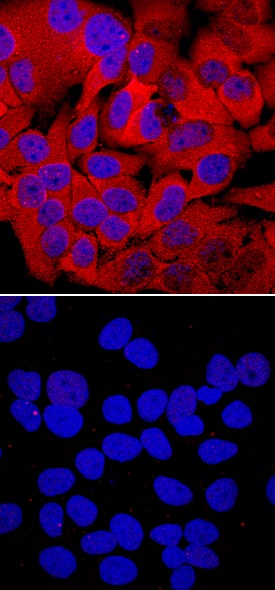Human Phospho-HSP27 (S78/S82) Antibody
R&D Systems, part of Bio-Techne | Catalog # MAB23141

Key Product Details
Validated by
Species Reactivity
Validated:
Cited:
Applications
Validated:
Cited:
Label
Antibody Source
Product Specifications
Specificity
Clonality
Host
Isotype
Scientific Data Images for Human Phospho-HSP27 (S78/S82) Antibody
Detection of Human Phospho-HSP27 (S78/S82) by Western Blot.
Western blot shows lysates of MCF-7 human breast cancer cell line and HeLa human cervical epithelial carcinoma cell line untreated (-) or treated (+) with 20 mJ/cm2ultraviolet light (UV) with a 30 minute recovery. PVDF membrane was probed with 1 µg/mL of Rabbit Anti-Human Phospho-HSP27 (S78/S82) Monoclonal Antibody (Catalog # MAB23141) followed by HRP-conjugated Anti-Rabbit IgG Secondary Antibody (Catalog # HAF008). A specific band was detected for Phospho-HSP27 (S78/S82) at approximately 27 kDa (as indicated). This experiment was conducted under reducing conditions and using Immunoblot Buffer Group 1.Phospho-HSP27 (S78/S82) in HeLa Human Cell Line.
HSP27 phosphorylated at S78/S82 was detected in immersion fixed HeLa human cervical epithelial carcinoma cell line unstimulated (lower panel) or stimulated with 20 mJ/cm2ultraviolet radiation (upper panel) using Rabbit Anti-Human Phospho-HSP27 (S78/S82) Monoclonal Antibody (Catalog # MAB23141) at a 10 µg/mL for 3 hours at room temperature. Cells were stained using the NorthernLights™ 557-conjugated Anti-Rabbit IgG Secondary Antibody (red; Catalog # NL004) and counterstained with DAPI (blue). Specific staining was localized to cytoplasm and nuclei. View our protocol for Fluorescent ICC Staining of Cells on Coverslips.Applications for Human Phospho-HSP27 (S78/S82) Antibody
Immunocytochemistry
Sample: Immersion fixed HeLa human cervical epithelial carcinoma cell line unstimulated or stimulated with 20 mJ/cm2 ultraviolet radiation
Western Blot
Sample: MCF‑7 human breast cancer cell line and HeLa human cervical epithelial carcinoma cell line treated with ultraviolet light (UV)
Reviewed Applications
Read 1 review rated 5 using MAB23141 in the following applications:
Formulation, Preparation, and Storage
Purification
Reconstitution
Formulation
Shipping
Stability & Storage
Background: HSP27
Heat shock proteins (HSPs) are a family of highly conserved stress response proteins. Heat shock proteins function primarily as molecular chaperones by facilitating the folding of other cellular proteins, preventing protein aggregation or targeting improperly folded proteins to specific degradative pathways. HSPs are typically expressed at low levels under normal physiological conditions but are dramatically up-regulated in response to cellular stress. Elevated levels of HSPs have been observed in association with ischemia/reperfusion, cancer, and chronic heart failure. HSP27 is a member of the small heat shock protein family, which also includes HSP25 and the alpha-crystallins. Ser78 and Ser82 of HSP27 are phosphorylated in vivo in response to growth factors or heat shock, and the extent of phosphorylation plays a role in determining specific functions. HSP27 forms a large oligomer and functions as an anti-apoptotic molecule, regulating apoptosis through direct interaction with key components of the apoptotic pathway. HSP27 binds and sequesters cytochrome c released from the mitochondria in response to an apoptotic stimulus. This prevents the proper assembly of the apoptosome and subsequently, the activation of procaspase-9 and procaspase-3.
References
- Gusev, N.B. et al. (2002) Biochemistry (Moscow) 67:511.
- Garrido, C. et al. (2001) Biochem. Biophys. Res. Commun. 286:433.
- Garrido, C. (2002) Cell Death Diffr. 9:483.
- Brvey, J-M. et al. (2000) Nat. Cell Biol. 2:645.
Long Name
Alternate Names
Gene Symbol
UniProt
Additional HSP27 Products
Product Documents for Human Phospho-HSP27 (S78/S82) Antibody
Product Specific Notices for Human Phospho-HSP27 (S78/S82) Antibody
For research use only

